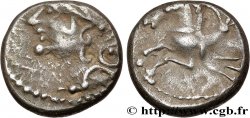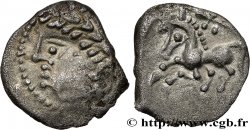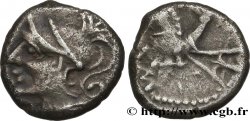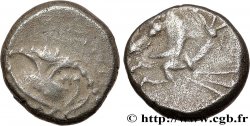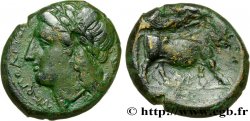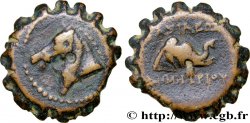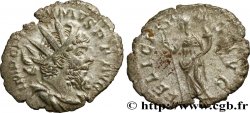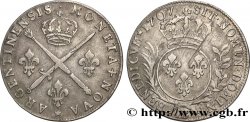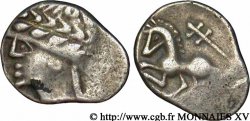v15_0458 - GALLIEN -ALLOBROGES (Region die Dauphine) Denier au cheval galopant et au “caducée”
MONNAIES 15 (2002)
Startpreis : 195.00 €
Schätzung : 400.00 €
Erzielter Preis : 195.00 €
Anzahl der Gebote : 1
Höchstgebot : 210.00 €
Startpreis : 195.00 €
Schätzung : 400.00 €
Erzielter Preis : 195.00 €
Anzahl der Gebote : 1
Höchstgebot : 210.00 €
Type : Denier au cheval galopant et au “caducée”
Datum: Ier siècle avant J.-C.
Metall : Silber
Durchmesser : 13,5 mm
Stempelstellung : 2 h.
Gewicht : 1,85 g.
Seltenheitsgrad : R1
Kommentare zum Erhaltungszustand:
Flan large et ovale, avec plat de frappe derrière la tête
N° im Nachschlagewerk :
Pedigree :
Cet exemplaire provient de MONNAIES II, 21 juin 1997, n° 110
Vorderseite
Titulatur der Vorderseite ANÉPIGRAPHE.
Beschreibung Vorderseite Tête laurée à gauche.
Rückseite
Titulatur der Rückseite ANÉPIGRAPHE.
Beschreibung Rückseite Cheval galopant à gauche ; au-dessus, “caducée”.
Kommentare
Cet exemplaire, lors de son classement dans MONNAIES II avait semblé être fourré en raison de la petite tache sur le menton. Associé à son poids léger, cette hypothèse semble avérée, bien que cette monnaie soit d’un aspect très agréable et d’une excellente conservation. Le petit numéro sur le revers indique une provenance d’un trésor étudié sans doute à la fin du XIXe ou début du XXe siècle.
This example, when classified in COINS II, appeared to be filled due to the small stain on the chin. Combined with its light weight, this hypothesis seems to be true, although this coin has a very pleasant appearance and is in excellent condition. The small number on the reverse indicates a provenance from a hoard studied probably in the late 19th or early 20th century.
This example, when classified in COINS II, appeared to be filled due to the small stain on the chin. Combined with its light weight, this hypothesis seems to be true, although this coin has a very pleasant appearance and is in excellent condition. The small number on the reverse indicates a provenance from a hoard studied probably in the late 19th or early 20th century.








 Berichten über einen Fehler
Berichten über einen Fehler Die Seite drucken
Die Seite drucken Teilen meiner Auswahl
Teilen meiner Auswahl Stellen Sie eine Frage
Stellen Sie eine Frage Einlieferung/Verkauf
Einlieferung/Verkauf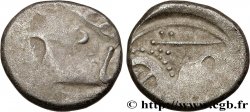
 Details
Details